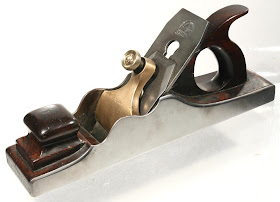Should have more than a one hundred years these tongue and groove planes. I picked up them from ebay, maybe they come from Austria or Germany. No marks on the plane body, neither on the blades.
They cut a 8 mm tongue and groove.
When I had them I noticed they needed a restoring job. The plane body showed numerous worm holes, although the wood was solid enough.

The main problem was that the wooden screws was blocked into the body and for two of them I cannot unscrew. The only solution was sawing the plane body for reach the thread and release the screw.
The damage was inevitable and a repair needed!
I dislike to have these tools only for collecting them; I love to use them too. So I attempted to a structural and functional recovery, preserving, if possible, their lived-in look with some sign of aging
After washing with soap and treated with an anti-worm product (although the old holes seemed empty), blades and steel skates received a anti-rust treatment.
The pieces were then re-glued and veneers were used for closing the saw grooves.
Then I closed the worm holes, leaving some intentionally.
The functional recovery concerned after all in to steady contact points (soles and fences). For this job I used mahogany strips. This wood is also present in the wedges and regulating screws.
The skate bed and sides were rectified by a big file and by sliding the plow on the abrasive paper while keeping it square.
The two half-skates are inserted into a groove of plane body. At heel ant toe, the skates have dovetail shape and are firmly held by a nail driven into the body.
One wooden screw has split while removing it and I had to repair by gluing.
All screws had difficulties to move in their threads, so I used a thin cylindric rasp for easy their action.

Blades are hand forged; the plow plane blade was worn-out, so I had to substitute it.
 I started from a 32 mm single plane iron, cut by a angle grinder (cooling often) and refinished at bench grinder.
I started from a 32 mm single plane iron, cut by a angle grinder (cooling often) and refinished at bench grinder. By looking at old blade, it shows a trapezoidal section and slightly tapered sides; this avoids the cutter binds into the groove walls, even if the plane rocks a bit.
Moreover, the original blades show a convex shape for a stronger holding of them by wedge; I imitate this for the new blade and it works.
Finally, I rectified the contact surfaces (soles and fences) for having the cutting edge square to the fence and parallel to the sole. Of course I tried to cut a joint.
























































